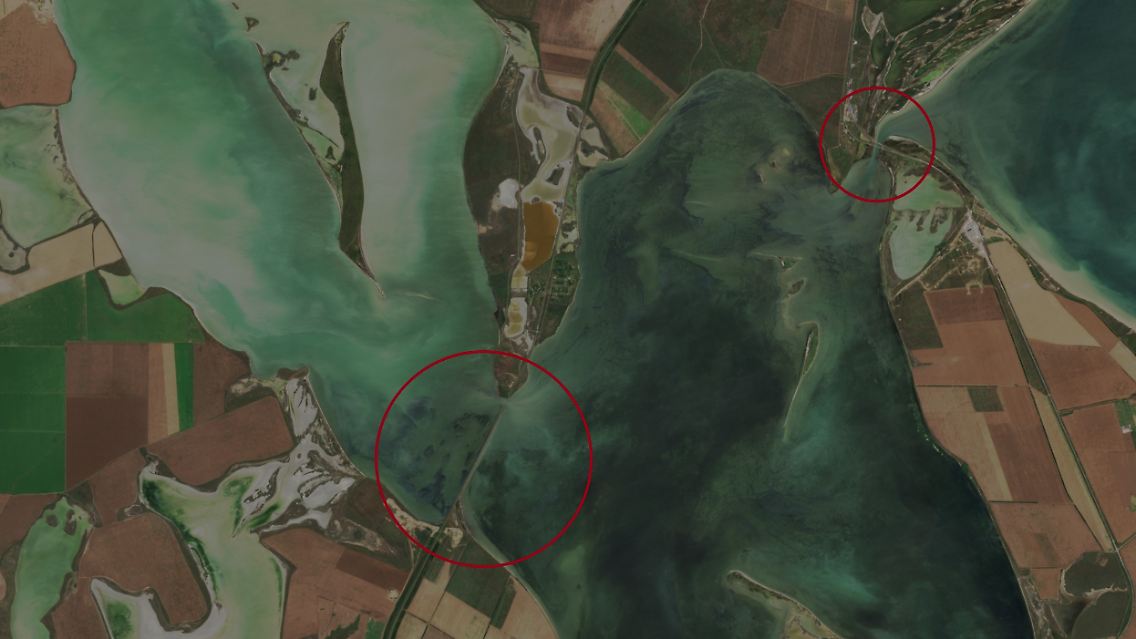Air strike far behind the front
Why the Chonhar Bridge is so important
By Martin Morcinek
6/22/2023, 3:07 p.m
The attack on the bridge near Chonhar hit the Russian occupying power in a vulnerable spot: the Ukrainians fired on one of the most important crossings to Crimea. A look at the map reveals the strategic importance.
In the early morning hours of June 22, violent explosions shook southern Ukraine: Far away from the front, several heavy calibers struck near Chonhar – the former border crossing point to the Russian-annexed Crimea. The targeted fire is apparently aimed at the two road bridges over the Syvash. The first pictures show severe damage to the road surface. Chonhar is about 120 kilometers away from the nearest Ukrainian positions.
The two road bridges at Chonhar are of considerable importance for traffic in the region. At this point, the important trunk road passes a natural bottleneck. Route M-18’s newer concrete bridge is adjacent to the old road bridge. The two comparatively short structures cross the main arm of the Syvash Bays here.
With the Chonhar incident, the Ukrainians are targeting one of the few land connections to Crimea: the salt marshes and marshlands of the Syvash stretch over a distance of almost 100 kilometers from the isthmus at Perekop in the west to the Arabat Spit on the Sea of Azov in the east . The backwater, which is up to 15 kilometers wide in a north-south direction, separates the Crimea from the mainland and is only passable for vehicles in a few places.
At Chonhar, the two road bridges lead close together over the “lazy sea”, as the Syvash is also called. In the early morning shelling, both connections were apparently hit, but not destroyed. The exact extent of the damage is still unclear, but the repairs could take several weeks, estimates an employee of the Ministry of Transport sent by Russia.
The situation before the attack: view of the railway bridge (left, large circle) and the road bridges near Chonhar (photo from June 20, 2023).
(Photo: © Sentinel Hub / ESA)
A few kilometers further west of Chonhar, the most important railway line leads towards Melitopol over the salt marshes and marshes of the Syvash. The railway line connects the Russian supply hub of Jankoy in Crimea with Melitopol near the Tokmak front. It is unclear whether the rail bridge over the Syvash was also shot at.
The attack at Chonhar posed considerable problems for the Russian military: large parts of the supplies for the fighting troops on the lower reaches of the Dnipro and on the Zaporizhia front used this route. If the Ukrainians cut this connection, supplies to the Russian front-line units would be at risk.
Whether artillery shells, food, machine gun ammunition, fuel or anti-tank weapons: the material consumption at the front is enormous. Without reliable supplies of supplies, according to the Ukrainians’ possible calculations, the Russian positions, which were built at great expense, cannot be held out for long against attacks by the Ukrainian ground offensive.
The fact that the Ukrainians are targeting the crossings to Crimea must also act as an alarm signal for the occupiers. If the Chonhar bridges are within range of Ukrainian precision attacks, then the military planners in the Kremlin must also expect precision shells to fall on the other supply routes at the entrance to Crimea.
There are hardly any short detours or alternative routes: the isthmus at Perekop is just under ten kilometers wide at its narrowest point. Apart from the railway bridge, there are only two narrow dams between Perekop and Chonhar. Otherwise, further east, only one road leads across the Arabat Spit.
The narrow tongue of land of the Arabat Spit separates the brackish swamps of the Syvash from the Sea of Azov. The spit consists mostly of alluvial sand. There is almost no cover on the more than 100-kilometer stretch from the mainland near Henichesk down to Kamjanske. And near Henichesk, the road runs over two small bridges, which could also soon come under fire.
